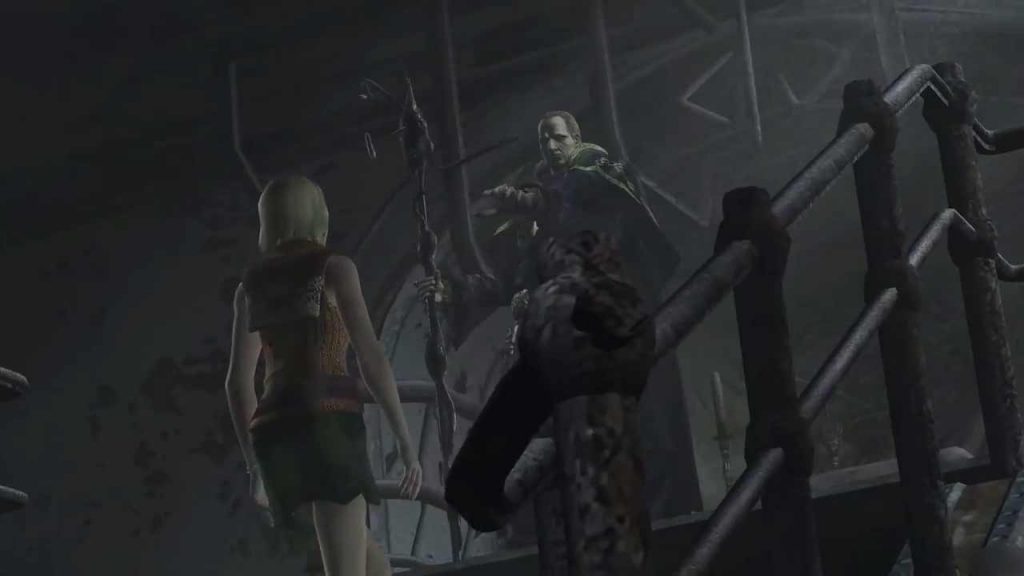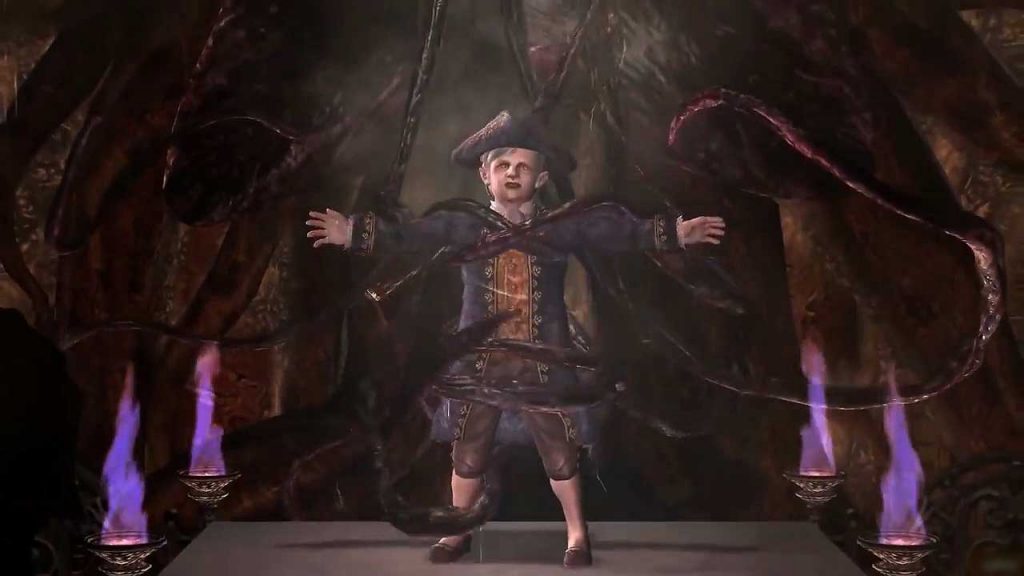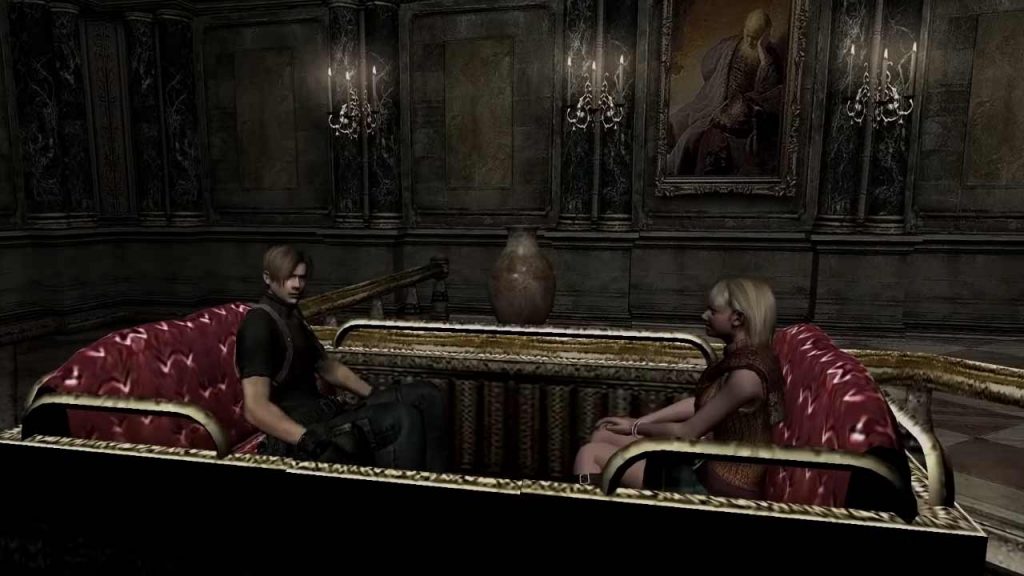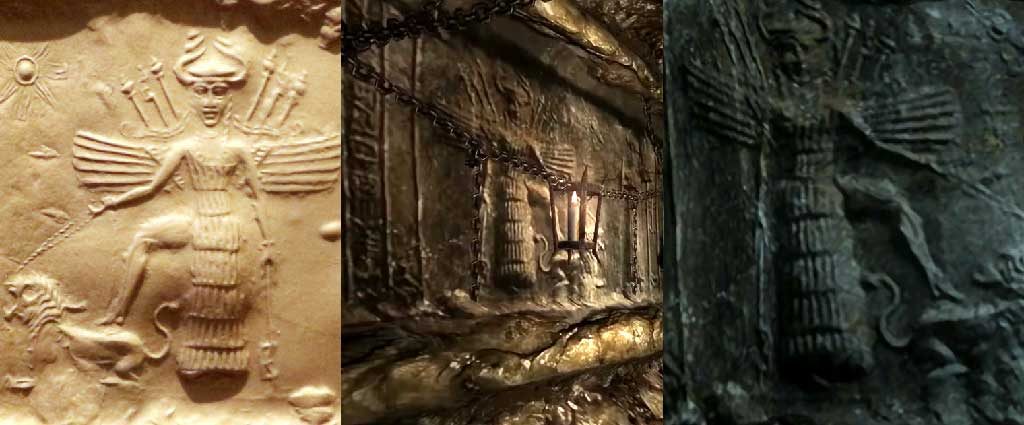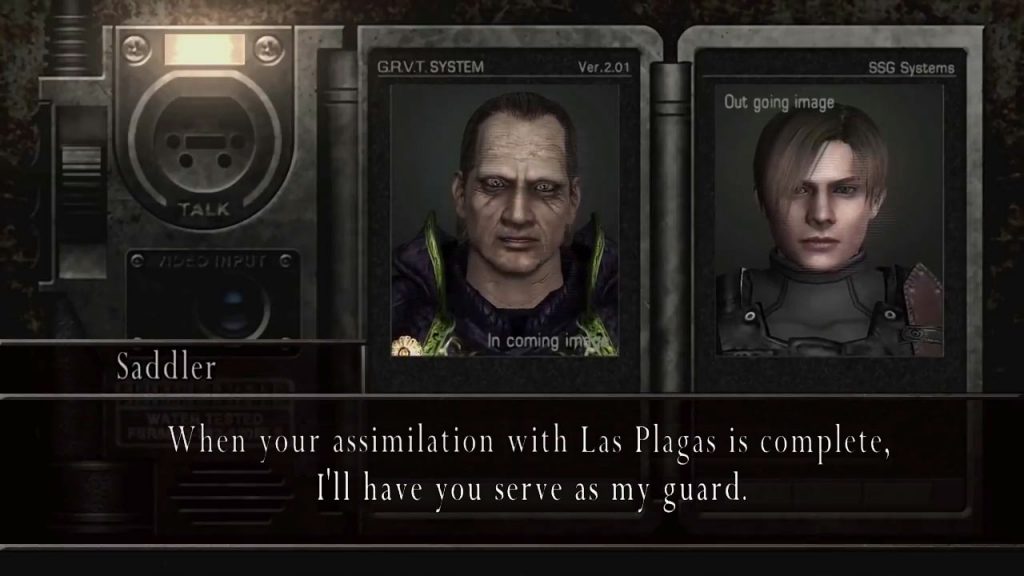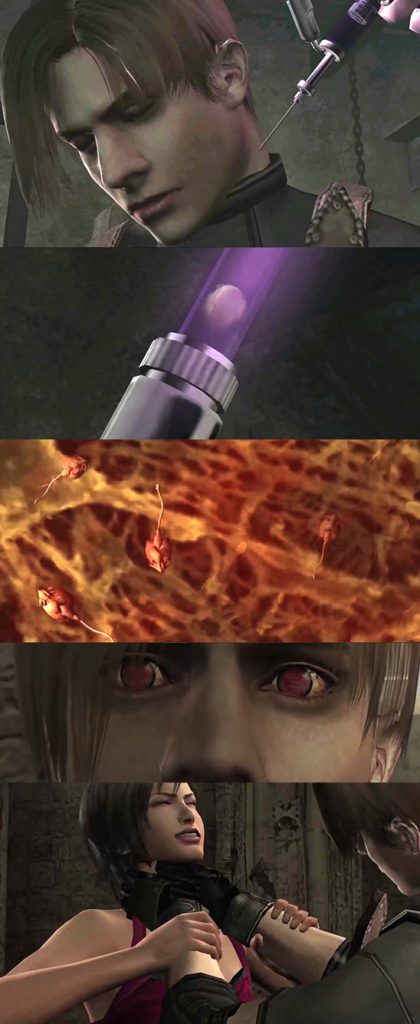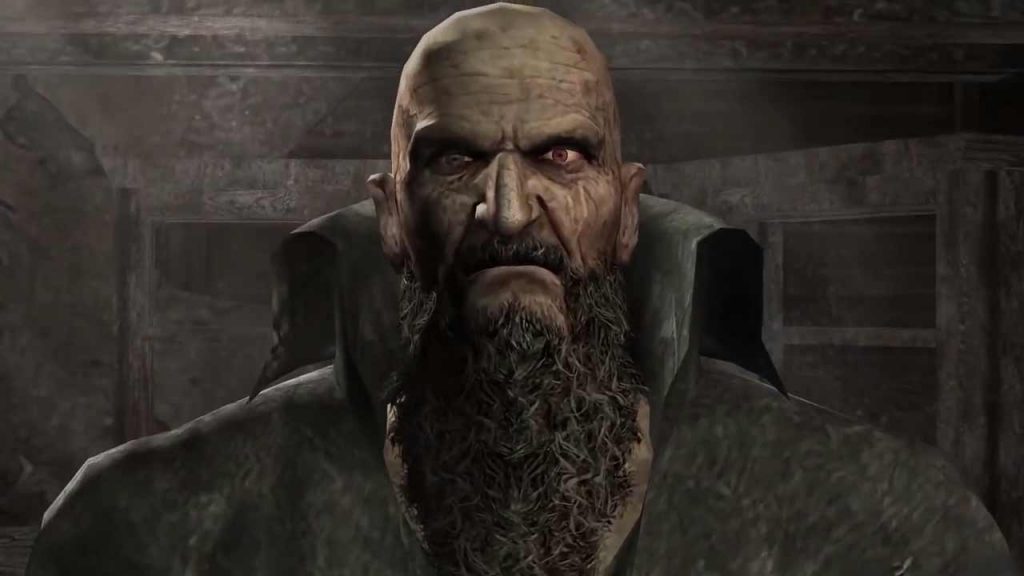The Hidden Meaning of Resident Evil 4
Famously based on zombie horror films, the Resident Evil video games have sold millions of copies each over the past two decades, and spawned a (terrible) film franchise to boot. As such, they’re an important cultural touchstone to a large segment of the gaming public, many of whom are young white men. The Japanese title Biohazard better communicates its central premise: A virus engineered by a multinational pharmaceutical company causes a pandemic resulting in the zombie apocalypse.
Resident Evil 4 is probably the most critically acclaimed game in the franchise and one of the best video games ever made. As of this writing, it has sold more than seven million copies, and enjoys an average score of ninety-six percent at Metacritic. It has ranked in the top thirty video games for fifteen years, and new editions have been published as recently as last month. If you’re not the gaming type but want to see the story, you can watch videos like this one on YouTube. It’s a bit disjointed, as it cuts out most of the in-game action, but you’ll get the gist.
Video game stories are frequently treated as secondary or unimportant by players and reviewers alike because they often fall short of those in film and television. Resident Evil 4 assumes the tone of cheesy 1980s action flicks – at times even breaking the fourth wall – but subverts player expectations with a major twist: A secret society controlled by parasitic organisms is planning to take over the world a la Invasion of the Body Snatchers, The Puppetmasters, or Conspiracy (Star Trek: The Next Generation, Season 1, Episode 25).[1]
In Resident Evil 4, we travel to an incredibly bizarre part of Spain that seems trapped in the seventeenth century. We find an unsettling rural farming village and an eerie medieval castle. What’s up with that little midget guy and the Satanic monks who defend him? Who is the merchant? Why reference the Illuminati? Why parasites instead of zombies? All of these questions and more will be answered.
The horror movie connection
Horror films exert a major influence on the series, with Resident Evil creator Shinji Mikami crediting George Romero’s zombie films as his primary inspiration. Having acknowledged that zombies had become boring, it’s likely that his team looked to John Carpenter’s The Thing for something different. The heads of enemies sometimes explode in a swirl of tentacles, revealing they’re actually controlled by alien parasites, and the full-grown ones can detach and run around independently, like the creature in the resuscitation scene in The Thing.
As for its plot, Resident Evil 4 borrows directly from Dagon, a low-budget horror film based on H. P. Lovecraft’s mythos. In it, a couple becomes stranded at a seaside fishing town where creepy Spanish locals belong to a cult. They worship and mutate into sea monsters – concealing their true nature with the skin of human victims – and kidnap the female lead as a sacrifice to the titular deity. Despite some rather striking similarities, Resident Evil 4 expands and improves upon Dagon‘s premise, borrowing elements from The Texas Chainsaw Massacre, Indiana Jones, Jaws, and The Lord of the Rings along the way.
Like Dagon, Resident Evil 4 takes place somewhere in Spain, though the country is never specified. There’s been some confusion on this point, because the actors hired out of America speak a Mexican dialect. However, the staff collected research material there, and the Spanish-speaking enemies, names, and currency (pesetas), not to mention the ex-cop from Madrid, Luis Sera, all point to it being Spain.[2] And, like Dagon, here we find a secret society/religious cult that assembles in church. This seems superfluous, given we already had a boogeyman in the Umbrella Corporation, but that’s binned in the introduction. We’re told that once its nefarious activities were exposed, its stocks crashed and it disappeared.
The Kennedy connection
Last seen as a rookie cop in Resident Evil 2, fan favorite Leon S. Kennedy returns as our protagonist. He’s reintroduced as a chiseled covert ops specialist tasked with rescuing the President’s daughter, Ashley. Like the damsel in distress in Dagon, she’s been kidnapped by a cult, but is distinguished by much higher status. This set-up works as a modern take on the classic tale of the knight in shining armor saving the princess.
Shinji Mikami’s games often feature conspiracies – such as those concerning the Umbrella Corporation – so it’s worth noting a small but important detail.[3] Leon’s name seems to be a reminder to Resident Evil‘s young audience of the Kennedy assassinations, and by extension recalls JFK’s famous warning of a ruthless conspiracy. Not only do they share surnames, but note his middle name is Scott, and JFK’s is Fitzgerald, which are married in the name of world-renowned author F. Scott Fitzgerald. This could be a further clue that Leon and JFK are indeed connected.
Besides that, others often refer to him as “Leon S. Kennedy,” where the middle initial gives his name a similar cadence to John F. Kennedy. I argue this, too, is intentional, because it’s extremely rare for video game characters to have a middle name at all. Leon was the first of three to get one in the franchise, with the others introduced after Shinji Mikami’s departure from Capcom.[4] Still unconvinced? The spy Ada Wong refers to Krauser as a “patsy,” echoing Lee Harvey Oswald’s famous line, and intimates that Leon is “the most essential part of this mission.”[5] The JFK assassination represents a major turning point in American politics if, as some theories suggest, there was deep-state involvement.
Is Resident Evil 4 anti-Semitic?
Once the aforementioned details have been established, Resident Evil 4 increasingly deviates from Dagon. Resident Evil 4‘s cult followers are not Lovecraftian deep-sea monsters, but the human hosts of an ancient parasite called “Las Plagas.” This is a distinction without a difference to the untrained eye, but parasites more clearly communicate who the cultists represent. Historically, the diaspora Jewish community has been accused of living parasitically on host populations because it’s a small, foreign group that latches onto larger non-Jewish societies to extract wealth without working via usury.
In “Luis’ Memo 4,” the Plagas researcher Luis Sera gives us the following description of the Plagas parasites. See if it sounds like anybody you know:
- Plagas have the ability to manipulate the behavioral patterns of their hosts.
- The Plagas are social organisms. By this I mean that instead of living individually, they live in perfect social harmony. It is believed that they have a collective intelligence.
- Plagas have exceptional adaptation skills. They are able to live off many kinds of organisms by creating a symbiotic environment quickly. This ability, when combined with social behaviors, allows them to interact intelligently between hosts regardless of the host organism.
That said, alien parasites are a common monster in video games, with several examples barely skirting copyright on H. R. Giger’s designs from Alien.[6] The vast majority of them utterly lack an anti-Semitic context and can be written off as nothing more than homage to great Hollywood movie monsters. Furthermore, any work drawing heavily from allegories of Jewish (or Communist) infiltration and subversion of goyishe society, such as The Thing, risks accidentally inheriting some contextual anti-Semitism, regardless of artistic intent. This could easily occur where cultural and linguistic barriers exist, as with Japanese video games borrowing elements from Western films. Therefore, it’s impossible to know if Resident Evil 4 is intentionally anti-Semitic – but I will demonstrate why I believe it is.
If you’re curious why a Japanese video game would assume an anti-Semitic posture, consider its development began shortly after the September 11, 2001 terrorist attacks, which many believe had Israeli fingerprints all over it. Also note that Mein Kampf has been taught in Japanese schools and The Protocols have sold well there. However, like many other anti-Semitic parables, its themes are veiled to avoid an organized backlash from vituperative Jewish organizations like the Anti-Defamation League. If the “working definition of anti-Semitism” is ever enforced in America, it could lead to games like Resident Evil 4 being banned or censored – especially if the self-appointed commissars at Google manage to achieve market dominance with digital distribution channels like Stadia. However, they’ll find it difficult to track down the millions of hard copies already circulating among the public, and any attempt at modifying its contents on PC can be remedied by patches designed to restore its original contents.
Upon its first publication in early 2005, the majority of its players were unaware of the Jewish Question and were certainly ignorant of Jewish history. Furthermore, some players – possibly Jews themselves – deflected from the Jewish angle by arguing it contained a coded anti-Islamic message, which fit the Zeitgeist of that time. With criticism of Jews a taboo and the War on Terror on everyone’s lips, the anti-Semitic subtext flew under the radar. Let’s correct that now.
Why does Resident Evil 4 take place in Spain?
Resident Evil typically involves conspiracies of one sort or another, but the fourth chapter goes after the Big Kahuna. Rather than inventing a wholly original name for its parasitic cult, the writers chose to name it “Los Illuminados,” a bald-faced reference to the Illuminati. It’s a household name that’s become a cliché, but few outside of conspiracy buffs know much about it. It seems to be deeply connected to Freemasonry.
When we combine Spain, people who are not what they seem who meet in church, and the Illuminati, it becomes obvious that Resident Evil 4‘s enemies are the Marranos, Spanish crypto-Jews who “converted” to Christianity to avoid expulsion.[7] Acting like double agents, the Marranos presented a Christian façade, but privately maintained their Jewish identities. They formed ethnic enclaves within the Catholic Church and founded the first known order of the Illuminati, the Alumbrado. Its members believed they were next to God and thus incapable of sin, freeing them from any sort of moral code. This explains why Resident Evil 4 doesn’t stray from Dagon in its Spanish setting when it would’ve been an effortless alteration to make.
Is Osmund Saddler based on a real person?
Unlike the fishy cult of Dagon, Los Illuminados members worship their leader Osmund Saddler, referring to him as “The Lord” and “Lord Saddler.” They’re often heard calling out to him as they perish, suggesting he is their god or messiah. With the established connection to crypto-Jews and the Illuminati, it follows that Saddler is based on self-declared Jewish messiahs. Unbelievably, these same messiahs preached a Satanic doctrine, and one of them had connections to the Illuminati.
First we have the Turkish-born Sabbatai Zevi, who in 1666 declared himself the Jewish messiah, giving rise to the Sabbatean Movement. According to Zevi, traditional rituals no longer applied to Jewish religious life. Instead, he preached the concept of “redemption through sin,” where transgression against God made one God-like (similar to the tenet of the Alumbrado). Promising a return to Palestine, roughly half of European Jewry believed he was the messiah. In Eastern Poland (now Ukraine) alone there were numerous Sabbatean secret societies by the end of the seventeenth century. However, Zevi’s self-proclaimed status as messiah collapsed when he converted to Islam under penalty of torture.
Note the 666 in Zevi’s story, the “number of the beast” in the Book of Revelation, which is clearly a warning about Jews. Six is a number with religious significance to Jews to which they ascribe mystical qualities. The number nine, an inverted six, is an unlucky number for Jews because it supposedly coincides with a number of calamities. There are three prominent sixes in Resident Evil 4: Leon says it has been six years since the Raccoon City incident in the introduction; after Leon’s nightmare, his handler says he was out of communication for exactly six hours; and there’s a puzzle in the castle parlor with the hint “the sacrifice of six lives shall make way the true path” (emphasis mine). The puzzle requires players to flip paintings until exactly six executions are shown.[8]
During a brief encounter with Saddler, he says they kidnapped Ashley for a large “donation,” emphasizing, “It takes a lot of money to keep this church up and running,” to which Leon replies, “Faith in money will lead you nowhere,” an unsubtle jab at the Grabblers in the audience. Then Leon and Ashley realize they’ve been injected with Plagas eggs (the problem is much closer to home than expected) complicating their escape. Saddler informs them that once the eggs hatch, he’ll control them like puppets. This hints that Ashley and Leon, who personify America and American patriots respectively, have been compromised by Jewish interests. We’ll come back to this theme later.
Is Ramon Salazar based on a real person?
The second act takes place in a medieval castle overlooking the dilapidated village, and here Resident Evil 4 really expands upon the concealed anti-Semitism of Dagon. We’re introduced to Ramon Salazar, the lord of the castle. Although the story takes place in 2004, he’s festooned like an eighteenth-century aristocrat. Figuratively, we’ve been transported back in time, and an important contextual clue is that Salazar suffers from a congenital disorder: Despite being twenty years old, he resembles a boy with wrinkly grey skin and hair, implying he is inbred. This aligns with European royalty’s historical tendency towards intermarriage.
Later, we find that Salazar had a three-story-tall statue made in his likeness, betraying a Napoleon complex. This fits, because Napoleon was the “Great Emancipator” of the Jews, just as Salazar was the one who “broke the seal” on the Plagas. The statue is actually a monstrous clockwork automaton that attacks Leon, so it can also be interpreted as a golem of Jewish folklore, a popular trope in video games.
In the second meeting with Salazar, Leon straight up asks him if he’s just another puppet of the parasites, to which he pompously replies that the parasites are “slaves to his will” and that he has “absolute control.” Self-deception is common of shabbos goyim, such as bought American politicians who act like they aren’t owned by the Jewish Lobby. Salazar’s butler opines in his diary that his master has been duped. Salazar eventually merges with the parasite to become a hideous monster, thus he can be interpreted as a scathing mockery of a consanguineous aristocracy that intermarried with prominent Jews.[9]
We learn that Plagas was discovered semi-fossilized deep underground in the mines administered by the Salazars, which was later injected into the locals by Los Illuminados. This echoes British historian Arnold Toynbee’s description of the Jews as “a historic fossil.” The subterranean origin also fits with the Marranos, who “went underground” by falsely converting to Christianity. When Leon stumbles upon them in this state, he wonders aloud how old they are (which, if you’re paying attention, is around 5,780 years). Incidentally, the mines contain sections full of molten lava evoking the pits of hell, which is fitting, as Jesus referred to the Jews as the Synagogue of Satan.
Salazar’s family has a large collection of paintings, some of which have encoded meanings. Ada’s meeting with Leon is set against Botticelli’s Spring, featuring Venus, the goddess of love, draped in red. Ada wears a red dress, and there’s sexual tension between her and Leon. There are two paintings that stand out within the anti-Semitic context. Players can’t miss Rembrandt’s Jeremiah Lamenting the Destruction of Jerusalem, as it appears prominently in the background during a minor transitional cut-scene. There’s also a painting of Neuschwanstein Castle, which was commissioned in honor of Richard Wagner. The latter wrote an anti-Semitic critique of Jewish composers, and to this day his work is banned in Israel. There are likely others that I haven’t been able to identify.
Who are the Satanic monks in Resident Evil 4?
Salazar’s castle is defended by Satanic monks in black and red robes who attack with medieval scythes, flails, and crossbows. Some even wear goat masks and wouldn’t look out of place in Stanley Kubrick’s Eyes Wide Shut (incidentally, its orgy scenes were filmed at a Rothschild mansion). We’ve already seen how one Jewish messiah preached a Satanic doctrine, but that doesn’t explain Salazar’s monks; to do so, we must reexamine the historical record.
We begin in 1491, where we find an example of a crypto-Jew named San Ignacio De Loyola who was born to a wealthy Marrano family in the Basque province of Guipuzcoa, Spain.[10] As a young man, De Loyola was initiated into the Illuminati which, mind you, was formed one year after his birth, suggesting his parents were somehow involved. He eventually moved to Rome and co-founded the Jesuit Order in 1539. This might explain why Pope Francis, the first Jesuit Pope – who ascended to the papacy in highly unusual fashion – is making so many concessions to the Jews and the globalist agenda.
Then, in the 1770s, a Polish Jew named Jacob Frank declared himself the reincarnation of Zevi and the new Jewish messiah. He founded the Sabbatean-Frankist movement (aka Frankism). Frank pushed Zevi’s doctrine of sin to new lows: worshipping Lucifer, Frankists allegedly engaged in objectively Satanic acts, including incestual orgies and child rape.[11] At its height, it boasted as many as half a million followers. Respected Jewish scholar Gershom Scholem described Frank as “the demonic tyrant.”
Around this time, a crypto-Jewish Jesuit and Freemason, Adam Weishaupt, founded a new order of the Illuminati.[12] Weishaupt appropriated the Catholic practice of confession in order to blackmail VIPs to expand his sphere of influence. He and Frank allegedly met in Frankfurt, where they made a pact to combine their memberships. I’m not well-versed in all of this, but suffice to say it appears that crypto-Jews, Jesuits, Satanists, and Illuminatis got along merrily, which explains the presence of Satanic monks willing to die for Saddler’s cult.
What about the Merchant, Novistador, Krauser, & El Gigante?
The mysterious merchant is a recurring character in Resident Evil 4, and one of its most popular (yes, the game has its own memetic merchant!). He’s the spitting image of one of the first extras seen in Dagon, has an Australian accent (likely just a flourish of the English voice actor), and appears to be infected with Las Plagas. He always seems to be one step ahead of Leon, but rather than attacking him, he sells him weapons. Given the anti-Semitic subtext, he surely personifies Jewish merchants who have historically profited from both sides of a conflict.
A new monster introduced in the second act is a large winged insect vaguely resembling a fly. These are called Novistador, a portmanteau of Spanish words meant to convey the “unseen” for their ability to camouflage themselves almost perfectly. They kill Leon by tackling him and regurgitating their stomach acids all over him, which is how flies digest food. They’re thematically consistent with the parasites hiding in plain sight, and Satanists who would revere Beelzebub (aka the Prince of Flies).
Murals in the Novistador’s cavernous lair are copies of Mesopotamian carvings of Inanna (Ishtar) – a Semitic goddess. Although she went out of vogue by the sixth century AD with the expansion of Christianity, her cult incredibly “survived in parts of Upper Mesopotamia as late as the eighteenth century.” She was chosen specifically: In the Akkadian version of Inanna’s descent into the Underworld, she threatens to “raise the dead who will outnumber and eat the living,” so she’s a perfect fit for Resident Evil. However, zombies are notably absent in Resident Evil 4, so the Semitic connection is more important here.
Additionally, we meet Krauser, an American agent who formerly worked with Leon. Faking his own death, he’s now an Umbrella Corporation agent out to steal a Plagas sample from Los Illuminados. He earned their trust by kidnapping Ashley, and merges with the parasite, believing it will grant him the strength needed to defeat Leon. After Leon kills Krauser, Saddler reveals that he would never trust an American and was planning on getting rid of him anyway! It seems Krauser personifies traitorous non-Jewish Americans who sell out their own country for personal gain, working for both the military-industrial complex and the Zionists.[13]
Leon encounters several giants infested with Plagas called “El Gigante,” which were likely inspired by the cave troll from The Lord of the Rings. They’re kept as slaves, which is appropriate given a disproportionate number of slavers from Spain and Portugal were Marranos. The first one is dragged out of its cage with a rope around its neck, and the ones in the mines wear chains. In this analysis, we can take it as a metaphor of the black-Jewish relationship. The Gigantes are sicced on Leon in the same way that Jews weaponized the black civil rights movement in America. More recently, the Jewish media whipped the black community into a frenzy in the lead-up to the 2016 presidential elections with gratuitous, one-sided coverage of police shootings. They’re also shown killing Ganados (villagers infected with Las Plagas), just as the alliance has sometimes backfired on Jews.
The United States as Zionist puppet
Having worked the historical angle, Resident Evil 4 reminds us that we have not magically traveled back in time with its final act. Set at an offshore research facility, infected mercenaries armed with miniguns and cattleprods protect a scientific lab where Plagas is studied. Here we see its power to control the mind: Leon was himself injected with Plagas earlier in the game, but until now he hasn’t suffered any serious ill effects besides losing consciousness. Saddler hypnotizes Ashley and tortures Leon by harnessing the parasites within them to gain the upper hand.
While briefly teaming up with Ada Wong, Leon’s Plagas takes control of his body and forces him to attack her. She stabs him in the thigh, breaking its hold on him before he can strangle her to death. Saddler even taunts Leon, telling him, “You’ve demonstrated quite a bit of promise . . . when your assimilation with Las Plagas is complete, I’ll have you serve as my guard.” Leon rejects the offer, saying he has “prior engagements” (i.e., to put America first).
If Plagas represents Jewish control and Leon personifies the patriotic American, then these scenes are metaphors of the Zionist tail wagging the American dog, such as inducing it to attack neutral (or even allied) powers against its own best interests. A similar scenario was playing out during Resident Evil 4‘s development when the US began the neocon-led invasions of Iraq and Afghanistan as a non sequitor to the September 11, 2001 terror attacks. Recall that as a pretext for the invasion, Israel claimed it had intelligence that Saddam Hussein possessed WMDs, – weapons that never materialized. Now, the same parasites and their infected host are trying to start a war with Iran.
Immediately preceding the finale, a secret document titled “Our Mission” lays bare the whole Jewish agenda.[14] It’s worth quoting in its entirety:
The real power of the United States lies in three areas. The Justice Department, the Administrative bodies, and the Military. In order to take control of these areas, we must influence the minds of the people who advise the President. After this is done, the rest of the departments will quickly fall under our sway. If by chance the United States were to figure out our plan, the damage caused should be minimal. We will still be able to conquer the country as planned using our backup plan. Once we control the country, we will use their international influence to our advantage. The rest of the world will fall swiftly. As already stated, if our first plan doesn’t go as smoothly as expected, we’ll proceed with our secondary plan. By sending in our “special” forces we will infiltrate the country from within. Fear and chaos will spread through the nation like a virus. It’ll only be a matter of time before the country loses its stability. At that time, when they’re most vulnerable, we will strike. Rejoice my brethren; the world shall soon be cleansed.
Los Illuminados kidnapped the President’s daughter and injected her with the parasite because only she could get close enough to the President to infect him. A New World Order would follow – one in which America became subordinate to Las Plagas. Thus, Ashley personifies an America that has fallen under the noxious spell of Zionism against its will. Leon even refers to this as terrorism, to which Salazar replies, “Isn’t that a popular word these days!” The secondary plan involving “special agents” and “fear and chaos” doesn’t at all imply the Mossad and the September 11, 2001 terror attacks, does it? Recall that Benjamin Netanyahu spoke before Congress and warned that if America did not attack Iraq, a nuclear bomb would be detonated at the World Trade Center next. Was that a prediction, or a threat?
A Jewish plot to ensnare the President through his daughter was prescient, as both Chelsea Clinton and Ivanka Trump went on to intermarry Jewish elites. Regardless of who won between Hillary Clinton and Donald Trump in the 2016 election, the Jews would enjoy a direct connection to the White House via a son-in-law. It follows the same pattern we saw earlier of Jewish social climbers marrying into the European aristocracy to secure power for themselves in an asymmetrical manner.
Conclusion
Resident Evil 4 is widely considered a masterpiece. That it also qualifies as one of a small handful of video games that can be described as anti-Semitic puts it in a very exclusive club (see also Half-Life 2), and for that it deserves to be recognized and celebrated by the Dissident Right. The surface narrative has a light-hearted B-movie quality, but there’s a very serious message boiling just beneath it. Its creators saw the negative role that Jews play in world affairs and conveyed their disgust in a thinly-veiled manner to an audience of millions. It’s a gift to the West from a small group of Japanese samurai.
In drawing on history and classic anti-Semitic motifs, it leaves breadcrumbs for players to follow: Parasites hiding in plain sight; Spain; the Illuminati; messianic movements preaching Satanic doctrines; and so on, but skirts controversy by obfuscating the common denominator. There is so much meme potential in its imagery that gamers interested in red-pilling their peers could have a field day. All it would take is slight alterations in Photoshop to bring its anti-Semitic themes to the forefront: forget Pepe, let’s promote Leon to his proper place as our icon! As previously mentioned, once this genie is out of the bottle, there isn’t much they can do without exacerbating the problem.
It’s therefore somewhat strange that a Google search brings up a solitary comment on the GameFAQs message board that says, “everyone knows Resident Evil is anti-Semitic.” This reads like Jewish projection; if everyone knows, why aren’t there any videos or articles discussing this or condemning it? Firstly, most players and professional reviewers don’t take conspiracy theories or video game plots seriously. Secondly, they are ignorant of the Jewish Question, Jewish history, and politics thanks to a complicit media and negligent education. Thirdly, those who understood its message remained silent because Jews are a protected class, and it’s taboo and professional suicide to talk about them.
If you’re new to the Jewish Question, watch this ten-minute explanation for an excellent primer. If you’d like to learn more, bookmark Counter-Currents and read it regularly. To better understand the negative role they play in Western society and culture, read The Occidental Observer, and Prof. Kevin MacDonald’s trilogy (especially The Culture of Critique). For a Christian perspective on the same, read Dr. E. Michael Jones’ The Jewish Revolutionary Spirit. Also research the Jewish role in Bolshevism and Communism. Finally, feel free to republish this article (in full, with credit and a link to this Website) to help spread awareness.[15]
Addendum: Resident Evil 5‘s racism scandal
Resident Evil 5 doesn’t contain any anti-Zionist messaging. Much of the key staff left in the intermediate years, and whoever took the helm probably wasn’t aware of Resident Evil 4‘s subtext. It’s set somewhere in Africa, where the Plagas can be mistaken as a metaphor for AIDS or the Ebola virus, and Umbrella is resurrected as the villain.
Some Spanish fans took offense at Resident Evil 4 – not realizing the villains were not actually Spanish at all – but it was accused of racism in the media. It contains spear-chucking black zombies in tribal masks, body paint, and grass skirts that the white protagonist mows down by the dozen. Despite the negative attention heaped on Resident Evil 5, no mainstream outlets have dared point out Resident Evil 4‘s anti-Semitic subtext. Make of that what you will.
Notes
[1] The Puppetmasters (1994) is a low-budget, loose adaptation of Robert A. Heinlein‘s The Puppet Masters (1951). Alien parasites land on Earth and begin to infiltrate the population. They cling to the upper spinal column and insert tentacles into the brain, controlling the victim like a puppet. The US government becomes compromised and the President is almost infected. Numerous Jews worked on the film, suggesting it was created to mock or stigmatize accusations of Jewish influence.
In the Star Trek episode, Starfleet Command has been taken over by a race of alien parasites that live in the throat. The infected look normal, betrayed only by a small stinger visibly protruding from the back of their necks. The parasite describes itself as “a superior form of life,” and in Resident Evil 4 the main villain calls humans “feeble” and compares killing them to swatting flies, mirroring the ethnic supremacist views of our chosenite friends.
[2] Luis Sera may be an author surrogate. He says of himself, “You put yourself on the line and nobody really appreciates you enough for it,” a fitting line given the risks the team took in making a game with such a controversial subtext. After Leon’s nightmare, a note from Luis says, “As for what’s going on with your body, if I could help you, I would, but unfortunately it’s beyond my power,” as if expressing the writers’ sympathies for America’s Zionist entanglement. Luis is stabbed in the back, but manages to provide some pills (of the red variety!) to temporarily suppress the parasite, giving the protagonists precious time. Synchronicity?
[3] Vanquish (Sega, 2010) is about a American-Russian war starring Russian bots before they became a meme, and The Evil Within (Bethesda, 2014) features a mysterious deep-state intelligence organization and mass mind control similar to that of The Matrix. Shinji Mikami’s newest game, Ghostwire: Tokyo, is about the “occult and conspiracies,” and its debut trailer features a character wearing Leon’s trademarked jacket from Resident Evil 4.
[4] Shinji Mikami told a Japanese interviewer that he would commit seppuku if Resident Evil 4 was released for the Playstation 2 (Hyper Capcom Special, summer 2002). Despite the threat, he was overruled by executives, prompting him and several colleagues to quit and form their own studios.
[5] In “Ada’s Reports 1-5,” she also mentions dog-whistles and describes Luis Sera as “a brilliant scientist researching Las Plagas who has accumulated a pile of data and pieced it all together” (he sounds like Prof. Kevin MacDonald!).
[6] A long list of titles would have to include Contra (Konami, 1987), R-Type (Irem, 1987), and Alien Syndrome (Sega, 1987).
[7] Japan was impacted by the Marranos. They made up a significant proportion of slavers who took Japanese as sex slaves and physical laborers (see The Yomiuri Shimbun, “Japanese slaves taken to Mexico in 16th century,” May 14, 2003, AsiaOne News). This was one of the reasons for Japan entering its isolationist period, though like the Atlantic Slave Trade, it is often blamed solely on Europeans.
[8] Besides the title, there is another prominent number four: Fighting Verdugo, the elevator takes exactly four minutes to arrive. It’s a Japanese double entendre, as the number four is considered unlucky because it can be read as shin, which also means “death.”
[9] In “Castellan Memo,” Salazar confirms he converted to the “religious group,” and justifies his allegiance to the Illuminados as a penance for their suffering under his gentile ancestors. This parallels the blank check the West has given the Jews following the Second World War stemming from Holocaust guilt.
[10] Guipuzcoa is perhaps the precise location. One of the Illuminados’ henchmen resembles a Semitic Rasputin, Bitores Mendez, and takes his name from the Basque bittore, meaning “victory.” Mendez is a Spanish name of Germanic origin linked to Sephardic Jews. Check out his ugly mug, which strongly resembles a certain meme:
[11] The predeliction towards incest among Orthodox Jews, the Sabbateans, and Freud’s bizarre theories is explained by J. Philippe Rushton’s Genetic Similarity Theory. Jews share an unusually high degree of relatedness due to their history of living in small, isolated populations&


